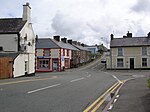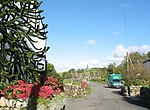Penygroes railway station

Penygroes railway station was located in Penygroes, Gwynedd, Wales.The narrow gauge, horse-drawn Nantlle Railway had a station near the site from 1856. From the outset timetables appeared regularly in the "Carnarvon & Denbigh Herald" and in Bradshaw from October 1856. In 1865 the narrow gauge line was closed, to be replaced and updated to standard gauge with contemporary facilities. It reopened in its eventual form in 1867 and closed in December 1964. The station served as the junction station for the short branch to Nantlle which was overlain in 1872 on part of the former Nantlle Railway route, but its main purpose was for traffic on the former Carnarvonshire Railway line from Caernarvon to Afon Wen and beyond.When the line and station were first opened in 1867 a locomotive was hired from the Cambrian Railways. A Cambrian driver, who had never been over the line before, was retained to drive the first directors' inspection special from Afon Wen to Carnarvon (Pant). On the return journey the loco ran short of coal and ran out of steam at Penygroes. There was some peat in a nearby field, which the crew dug and the directors carried to the engine enabling steam to be raised.The passenger service along the Nantlle Branch was withdrawn in 1932, though excursions continued until 1939. The station and line closed on 7 December 1964 as recommended in the Beeching Report. The station building and footbridge remained in place, but increasingly derelict, until at least 1970.
Excerpt from the Wikipedia article Penygroes railway station (License: CC BY-SA 3.0, Authors, Images).Penygroes railway station
A487,
Geographical coordinates (GPS) Address Nearby Places Show on map
Geographical coordinates (GPS)
| Latitude | Longitude |
|---|---|
| N 53.0524 ° | E -4.2886 ° |
Address
A487
LL54 6NZ , Llanllyfni
Wales, United Kingdom
Open on Google Maps









